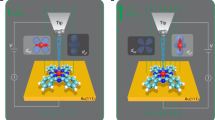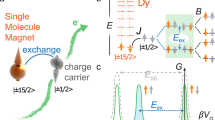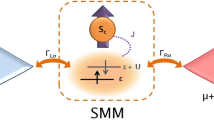Abstract
Single-molecule spintronics investigates electron transport through magnetic molecules that have an internal spin degree of freedom1. To understand and control these individual molecules it is important to read their spin state2. For unpaired spins, the Kondo effect has been observed3,4,5,6,7,8 as a low-temperature anomaly at small voltages. Here, we show that a coupled spin pair in a single magnetic molecule can be detected9,10 and that a bias voltage can be used to switch between two states of the molecule. In particular, we use the mechanically controlled break-junction technique11 to measure electronic transport through a single-molecule junction containing two coupled spin centres that are confined on two Co2+ ions. Spin–orbit configuration interaction methods are used to calculate the combined spin system, where the ground state is found to be a pseudo-singlet and the first excitations behave as a pseudo-triplet. Experimentally, these states can be assigned to the absence and occurrence of a Kondo-like zero-bias anomaly in the low-temperature conductance data, respectively. By applying finite bias, we can repeatedly switch between the pseudo-singlet state and the pseudo-triplet state.
This is a preview of subscription content, access via your institution
Access options
Subscribe to this journal
Receive 12 print issues and online access
$259.00 per year
only $21.58 per issue
Buy this article
- Purchase on Springer Link
- Instant access to full article PDF
Prices may be subject to local taxes which are calculated during checkout




Similar content being viewed by others
References
Sanvito, S. Molecular spintronics. Chem. Soc. Rev. 40, 3336–3355 (2011).
Schmaus, S. et al. Giant magnetoresistance through a single molecule. Nature Nanotech. 6, 185–189 (2011).
Iancu, V., Deshpande, A. & Hla, S-W. Manipulation of the Kondo effect via two-dimensional molecular assembly. Phys. Rev. Lett. 97, 266603 (2006).
Parks, J. J. et al. Tuning the Kondo effect with a mechanically controllable break junction. Phys. Rev. Lett. 99, 026601 (2007).
Osorio, E. A. et al. Electrical manipulation of spin states in a single electrostatically gated transition-metal complex. Nano Lett. 10, 105–110 (2010).
Park, J. et al. Coulomb blockade and the Kondo effect in single-atom transistors. Nature 417, 722–725 (2002).
Liang, W., Shores, M. P., Bockrath, M., Long, J. R. & Park, H. Kondo resonance in a single-molecule transistor. Nature 417, 725–729 (2002).
Meir, Y., Wingreen, N. S. & Lee, P. A. Low-temperature transport through a quantum dot: the Anderson model out of equilibrium. Phys. Rev. Lett. 70, 2601–2604 (1993).
Baadji, N. et al. Electrostatic spin crossover effect in polar magnetic molecules. Nature Mater. 8, 813–817 (2009).
Lehmann, J., Gaita-Arino, A., Coronado, E. & Loss, D. Spin qubits with electrically gated polyoxometalate molecules. Nature Nanotech. 2, 312–315 (2007).
Reichert, J. et al. Driving current through single organic molecules. Phys. Rev. Lett. 88, 176804 (2002).
Palii, A., Tsukerblat, B., Clemente-Juan, J. M. & Coronado, E. Magnetic exchange between metal ions with unquenched orbital angular momenta: basic concepts and relevance to molecular magnetism. Int. Rev. Phys. Chem. 29, 135–230 (2010).
Fink, K., Wang, C. & Staemmler, V. Superexchange and spin–orbit coupling in chlorine-bridged binuclear cobalt(II) complexes. Inorg. Chem. 38, 3847–3856 (1999).
Staemmler, V. & Fink, K. An ab initio cluster study of the magnetic properties of the CoO(0 0 1) surface. Chem. Phys. 278, 79–87 (2002).
Costi, T. A., Hewson, A. C. & Zlatić, V. Transport coefficients of the Anderson model via the numerical renormalization group. J. Phys. Condens. Matter 6, 2519–2558 (1994).
Nagaoka, K., Jamneala, T., Grobis, M. & Crommie, M. F. Temperature dependence of a single Kondo impurity. Phys. Rev. Lett. 88, 077205 (2002).
Parks, J. J. et al. Mechanical control of spin states in spin-1 molecules and the underscreened Kondo effect. Science 328, 1370–1373 (2010).
Hirjibehedin, C. F. et al. Large magnetic anisotropy of a single atomic spin embedded in a surface molecular network. Science 317, 1199–1203 (2007).
Costi, T. A. et al. Kondo decoherence: finding the right spin model for iron impurities in gold and silver. Phys. Rev. Lett. 102, 056802 (2009).
Romeike, C., Wegewijs, M. R., Hofstetter, W. & Schoeller, H. Quantum-tunneling-induced Kondo effect in single molecular magnets. Phys. Rev. Lett. 96, 196601 (2006).
Romeike, C., Wegewijs, M. R., Ruben, M., Wenzel, W. & Schöller, M. Charge switchable molecular magnet and spin blockade of tunneling. Phys. Rev. B 77, 064404 (2007).
Secker, D. et al. Resonant vibrations, peak broadening, and noise in single-molecule contacts: the nature of the first conductance peak. Phys. Rev. Lett. 106, 136807 (2011).
Ruben, M. et al. Charge transport through a Cardan-joint molecule. Small 4, 2229–2234 (2008).
Elbing, M. et al. A single-molecule diode. Proc. Natl Acad. Sci. USA 102, 8815–8820 (2005).
Reed, M. A., Zhou, C., Muller, C. J., Burgin, T. P. & Tour, J. M. Conductance of a molecular junction. Science 278, 252–254 (1997).
Meier, U. & Staemmler, V. An efficient first-order CASSCF method based on the renormalized Fock-operator technique. Theor. Chim. Acta. 76, 95–111 (1989).
Weigend, F. & Ahlrichs, R. Balanced basis sets of split valence, triple zeta valence and quadruple zeta valence quality for H to Rn: design and assessment of accuracy. Phys. Chem. Chem. Phys. 7, 3297–3305 (2005).
Acknowledgements
The authors acknowledge funding from the DFG under the framework of the SPP 1243 ‘Quantum transport on the molecular scale’ and the Transregio SFB TRR88 ‘3MET’. The authors thank R. Herchel for help in interpreting the magnetic bulk data, and H. Görls and G. Vaughan for X-ray structural analysis of ligand L. M. Fischer is thanked for measuring the elemental analysis. The authors also appreciate discussions with P. Müller.
Author information
Authors and Affiliations
Contributions
M.R. and H.B.W. conceived and designed the experiments. S.W., F.K. and S.B. performed the MCBJ experiments. Synthesis and full characterization of the chemicals were performed by R.C. (ligand L) and F.S. (complex 1). Quantum-chemical calculations were performed and analysed by T.B. and K.F. O.F. determined the single-crystal X-ray data of complex 1. S.W., F.K., S.B., F.S., T.B., K.F., M.R. and H.B.W. co-wrote the paper. All authors discussed and commented on the manuscript. Correspondence should be addressed to F.S. (synthesis), K.F. (theory) and H.B.W. (experiment).
Corresponding authors
Ethics declarations
Competing interests
The authors declare no competing financial interests.
Supplementary information
Supplementary information
Supplementary information (PDF 1489 kb)
Rights and permissions
About this article
Cite this article
Wagner, S., Kisslinger, F., Ballmann, S. et al. Switching of a coupled spin pair in a single-molecule junction. Nature Nanotech 8, 575–579 (2013). https://doi.org/10.1038/nnano.2013.133
Received:
Accepted:
Published:
Issue Date:
DOI: https://doi.org/10.1038/nnano.2013.133
This article is cited by
-
A Gd@C82 single-molecule electret
Nature Nanotechnology (2020)
-
Combining Molecular Spintronics with Electron Paramagnetic Resonance: The Path Towards Single-Molecule Pulsed Spin Spectroscopy
Applied Magnetic Resonance (2020)
-
Advance of Mechanically Controllable Break Junction for Molecular Electronics
Topics in Current Chemistry (2017)
-
Switching Effects in Molecular Electronic Devices
Topics in Current Chemistry (2017)
-
Field-induced conductance switching by charge-state alternation in organometallic single-molecule junctions
Nature Nanotechnology (2016)



